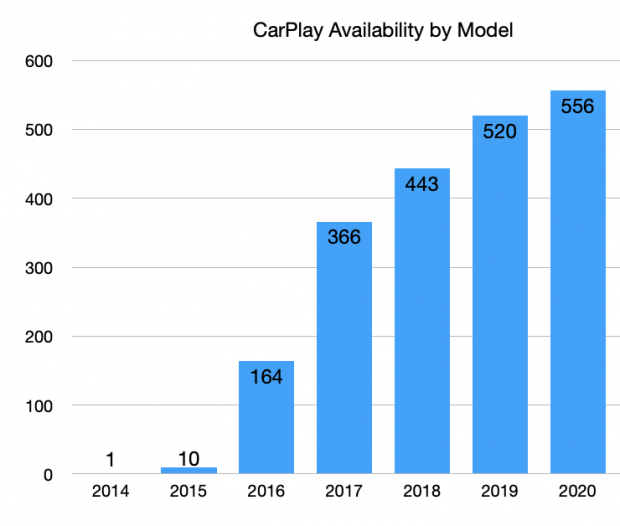Five years ago I used the Cook Doctrine (put forward 12 years ago) to assess the possibility of Apple’s entry in the car market. That doctrine states, among other things:
We believe that we need to own and control the primary technologies behind the products we make, and participate only in markets where we can make a significant contribution.
Tim Cook
I concluded that it was not a question of if, but of how and to what degree Apple could make a significant contribution. How in terms of control of the technology and to what degree in terms of significance of contribution.
It was a tough call five years ago and it’s still a tough call today. Arguably the failure of initial efforts to meet the Cook doctrine have caused resets and reboots and pivots which means no entry is visible in the near future.
But there is another effort that Apple has undertaken in the automotive space which might be indicative of their intentions and capabilities.
This is an effort that hardly gets mentioned and was dismissed as immaterial a long time ago but I would argue it has made a contribution. It’s also unique for Apple in being a licensed software technology made available to hundreds of licensees and extending a software and services strategy to non-Apple hardware.
I am speaking, of course, of CarPlay.
CarPlay was announced almost exactly 6 years ago. It implements a unique division of labor between the iPhone and the on-board hardware. A division that keeps most of the computation and data on the phone but displays and allows inputs through the car. As a result it can evolve with new versions of iOS while keeping car inputs and outputs functional even when they age well beyond the lifespan of several iPhone generations.
It can be argued that CarPlay is a necessary “connector” for the iPhone for that one hour a day that many iPhone users spend in their cars. It is effectively a better way to control the iPhone and have it be the “brains” of the infotainment system. In that regard it’s very similar to Apple TV: controlling the “dumb” TV without having to be a screen. The difference here is that CarPlay does not need an Apple remote.
But how is this significant? It improves things, sure. It improves most in-car experiences related to making calls, music, navigation, calendar, messaging, podcasts and news. It also seems to have traction.
The measure of any product introduction should be adoption and in that regard CarPlay could also be seen as significant in its departure from the Apple play book.
Because the adopters are not users but carmakers, the decision to deploy it depends on it being licensed and put into cars that are produced and made available. Quite a different set of hurdles, these are the “orifices” that Steve Jobs famously riled against.
One of the aspects of adoption by institutions vs. adoption by consumers is that whereas consumers are influenced by an early adopter calculus followed by the observation and imitation of others, for institutions there is a long delay with indecision followed by a rush to do adopt in unison with competitors. In other words, the adoption curve for consumers is a continuous gradual uptake whereas for institutions it’s a flat line followed by near-vertical step function.
We can see this with the following graph showing the number of car models supporting CarPlay for the model years they represent.

2014 and 2015 were very tepid but 2016 and 2017 saw huge leaps in adoption. Since then there has been a steady filling out of support. At this point in time about 600 car models support CarPlay which is very nearly all the models available in the US market and a substantial number for the markets where the iPhone is widely used.
So is CarPlay significant and can it provide control? On the control side the answer is a tentative yes. CarPlay creates an iOS bubble in the car and it sustains the iPhone ecosystem with no incursions by alternatives likely. [Android Auto which seems to have a similar degree of adoption does the same for Android but there is no “pull” of switchers from one to the other.] Anecdotally, CarPlay support has become a hygiene issue with carmakers. Having it offers few advantages but not having it may repel users.
On the significance question, the answer should be “it depends”. The support seems substantial but it’s hard to assess market share of models as a complete list of car models available is not easily obtained. Apple has effectively injected software in a lot of cars and done so relatively quickly. By licensing it has amplified its reach much in the way Microsoft did with Windows and the Intel PC in the 90s. The speed is remarkable because everything in the car industry happens very slowly.
More than 1000 licensed car models in 4 years. This is quite a feat.
But the software touches only a fragment of the car. Infotainment is important, perhaps more than anything else the user perceives about the car experience. But it has not changed what the car is. It has not made driving safer nor more productive or more efficient.
Messaging and calling and mapping/navigation notwithstanding, significance needs to be measured in more important terms. The iPhone is significant precisely because an iPhone is not a Phone. The Apple Watch is significant because it’s not a Watch. AirPods are significant because they are not just acoustics.
CarPlay would be significant if it made the car something it isn’t and not keep the car being what it is. We know it should be something else and that is what we are all waiting for.
Discover more from Asymco
Subscribe to get the latest posts sent to your email.
